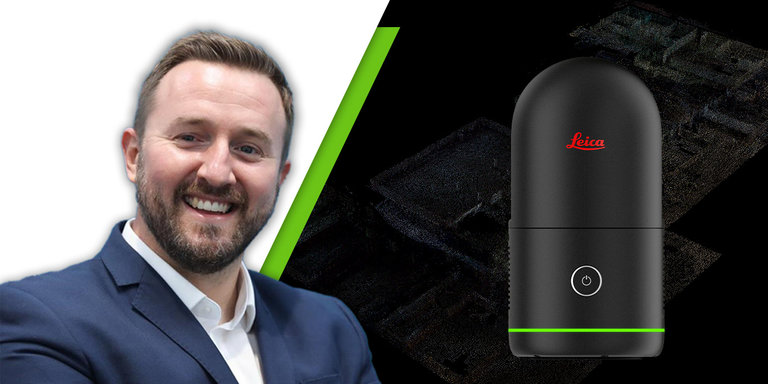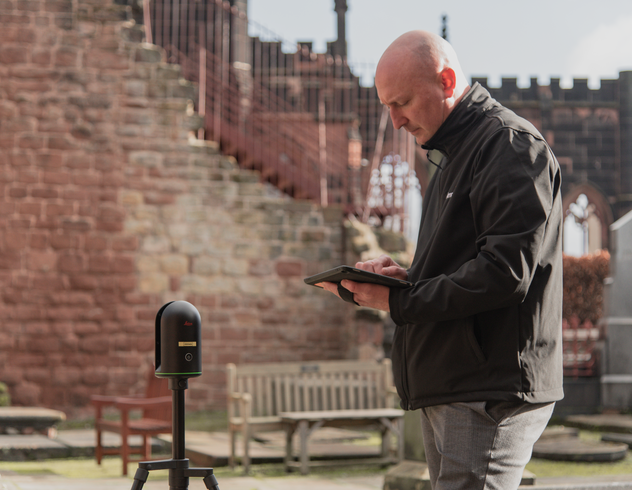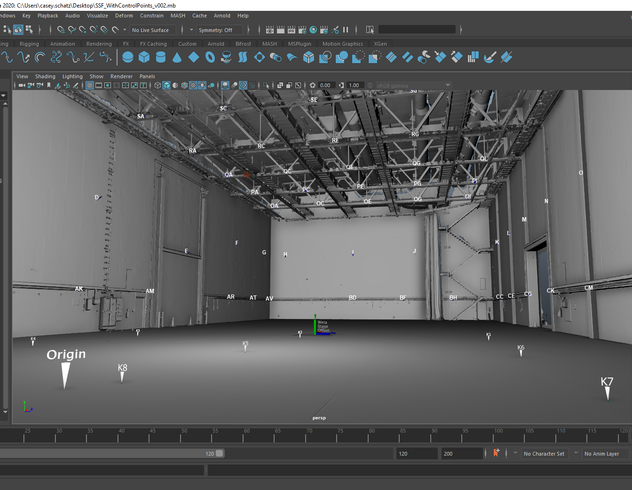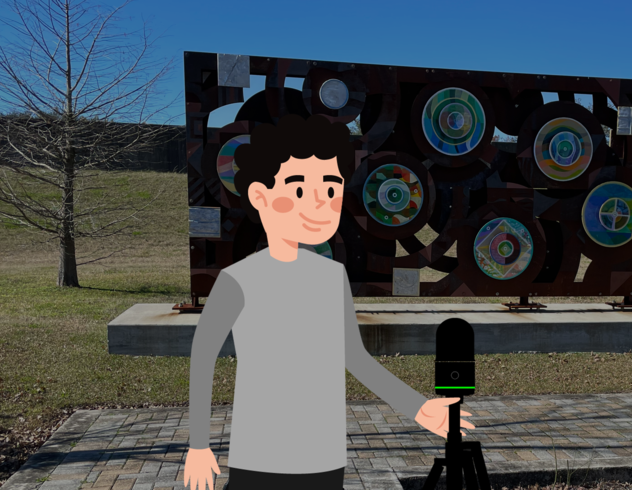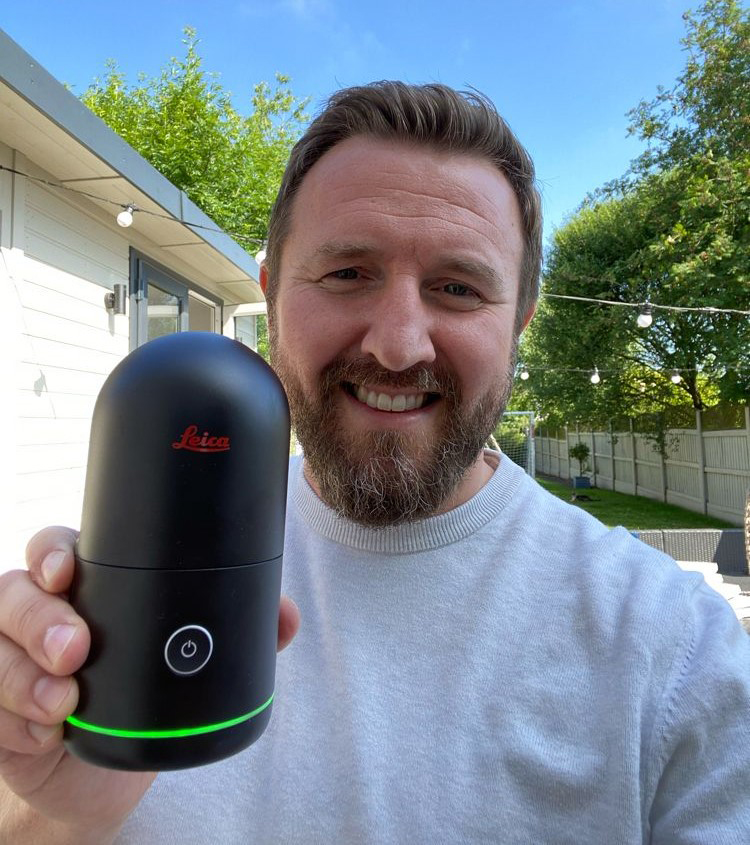
Paul Burrows is the Principal Software Solutions Manager for Leica Geosystems. But most people know him simply as the Reality Capture Guy on social media, YouTube, and his podcast. Paul's passion for and skill with reality capture products, from field work to meshing and beyond, are bar none. And he's generous with his time and knowledge, as evidenced by the many friends and colleagues in the laser scanning community he supports through his LinkedIn posts.
With the release of the new Leica BLK360, we decided to lean on that generosity to get his impressions of the device from prototype to launch and talk about some of the advantages this next-generation scanner has over its predecessor – and where he's taken it.
You've been with Leica Geosystems for 15 years. I understand you were on the ground floor with the new BLK360 too. What was that like?
I was part of the original team around the first generation BLK360, so I remember going to Switzerland and being whisked off in a car to go and meet with Burkhard, our CTO, and there was a group of maybe 10-12of us in this top-secret room, and then they brought out the original BLK360 – it was just incredible! And you look at that amazing product which has now been out for 5 years and think, "How can you make it smaller? How can you miniaturize it? How can you improve it? Is it even possible?"
From there (and more recently), I had some interactions with very early prototype models of this new scanner. We all knew it was going to be small; we knew it was going to be amazing. Luckily, I had the final device well in advance of the release at HxGN Live to put it through its paces on some tricky jobs
Let's talk about the new BLK360. Having had plenty of experience with the original, what stands out with the new unit?
The new generation BLK360 is just tiny, like the feel of a can of Coke in your hand or a small beer [laughs] – in profile it was smaller than my iPhone! So that was the first thing that struck me was just the sheer size of it – or lack thereof. Then you start understanding how fast it is. Even though the original device was quick, when you compare it to what you can achieve now, it's markedly faster.
Obviously, the new BLK360 is an iteration, an improvement, an enhancement over the original but at the same time it feels like a brand-new product line with new cameras and added VIS technology [Visual Inertial System] technology. It's a complete reworking of a very successful product and it feels fresh!
What would you describe as the flagship feature?
Probably the new VIS technology, which we learned and adapted from the Leica RTC360 and BLk2GO. VIS enables you to move from position to position and see your tracking between those positions when you use the BLK Live app. Whether you're pressing the button on the device or pressing the “start” button within the app itself, it is very straightforward to manage your data and see the process of pre-registering your scans.
The other significant advantage is the ability to export your data in the field, if needed. If you're using Cyclone FIELD 360 on a phone or tablet, it syncs all the data from the device – very quickly. We're then writing back transformations to the device as well – which gives the user more choice as to where they access their data. If you want to create your registration within Cyclone REGISTER 360 and Cyclone FIELD 360 – you can! However, you can also export an E57 [a vendor-neutral common point cloud file format ] of that registered bundle directly from Cyclone FIELD 360, or you can download the raw E57’s from the BLK Live app without registration data and use it in other 3rd party solutions. And that's part of the narrative moving forward - giving people much more control and doing stuff in the field at the point of capture. In the future, we are adding the ability to send data to our HxDR cloud platform too…
To me, the new BLK360 is genuinely the most open product that we've produced in a long, long time in terms of how you decide how you want to work with your collected data.
Were there any little changes you appreciated?
The other major thing (and not so little in fact) is that we've got the USB-C port right on the side now – visible for everyone to see! Before, it was all a bit tricky in terms of wireless connectivity and downloading the data. Now, you connect to it, and you download the data. Plug it in and get it from BLK Data Manager, or if you want to simply import the data straight into REGISTER 360.
In terms of how the new BLK360 performs in the field, what are you doing differently now that you weren't doing before?
The first thing I noticed is that I have to use the delay feature now because it's so fast. I have to delay it by 10 seconds, at least, so that I can get far enough away [laughs]. Of course, this doesn’t matter so much if you’re triggering the device remotely using the various apps we have.
The second thing is the sheer speed. I scanned my village, which I could do very quickly with VIS turned on in the high sun, in the middle of the day, and in hot temperatures (for the UK, at least). I could track it on the app and see the data coming in real-time. And I did it incredibly quickly –28 setups in half an hour – including moving the scanner between positions.
And when you look at the data, the data is so good for a device that size. Yes, it's not RTC360 or P-series quality, but it's not designed to be. It's plus or minus 4 millimeters at 10 meters. The one thing I did as a check was I went back to my RTC360 and BLK2GO data of the same area, and you can bring it all together within Cyclone REGISTER 360 and see that they are almost perfectly aligned. So, we're using a 20,000 euro scanner and then using devices that are 45,000 euros and 50,000 euros, and the data is all pretty much bang-on in terms of levelness. And I didn't use targets or any control points. Of course, the RTC360 gives data at longer ranges, and you can capture the same area in less time with the BLK2GO – each device has its strengths.
Internally, I know we talk a lot about how the new BLK360 isn't just a version 2.0 but an attempt to be as revolutionary as the BLK360 G1 was. What do you think this new scanner offers in terms of those impacts?
I've heard this phrase before, and I think it fits nicely for the new BLK360- this is a “time compression” technology. Whether it's capturing the data faster, processing it faster, or creating deliverables faster, we just want to get people to the right end result as quickly as possible.
The beauty of it is if I look back now at some of my really embarrassing videos where I've got scans that I'd made with the Leica HDS 3000 in front of a pub back in 2006 – I was super impressed by these two low-resolution scans I put together which likely took me around an hour. Now, I look at it, and I know I can do that same capture in maybe three or four setups – perhaps five minutes of work with the new BLK360, and it will be all stitched together automatically and could be uploaded to the cloud from the site using a mobile phone
I think for the people who haven't been on the whole journey, it must be very hard to appreciate how far we've come – but trust me – we have…and fast!
Final thoughts?
One thing I like is that this scanner isn't just for buildings trades. We're growing into new applications, whether VR, AR, film, or visual effects. For a long time, there have been people dedicated to capturing LIDAR for those markets. And now we're putting it in the hands of the technical directors and the creative producers rather than just a specialist group.
For me, the closer you get to the creative process, to ingratiate yourself in that process, the more people request it and the more popular it becomes.
I genuinely cannot wait to see what these creators make with the help of our technology – that is what excites me.

